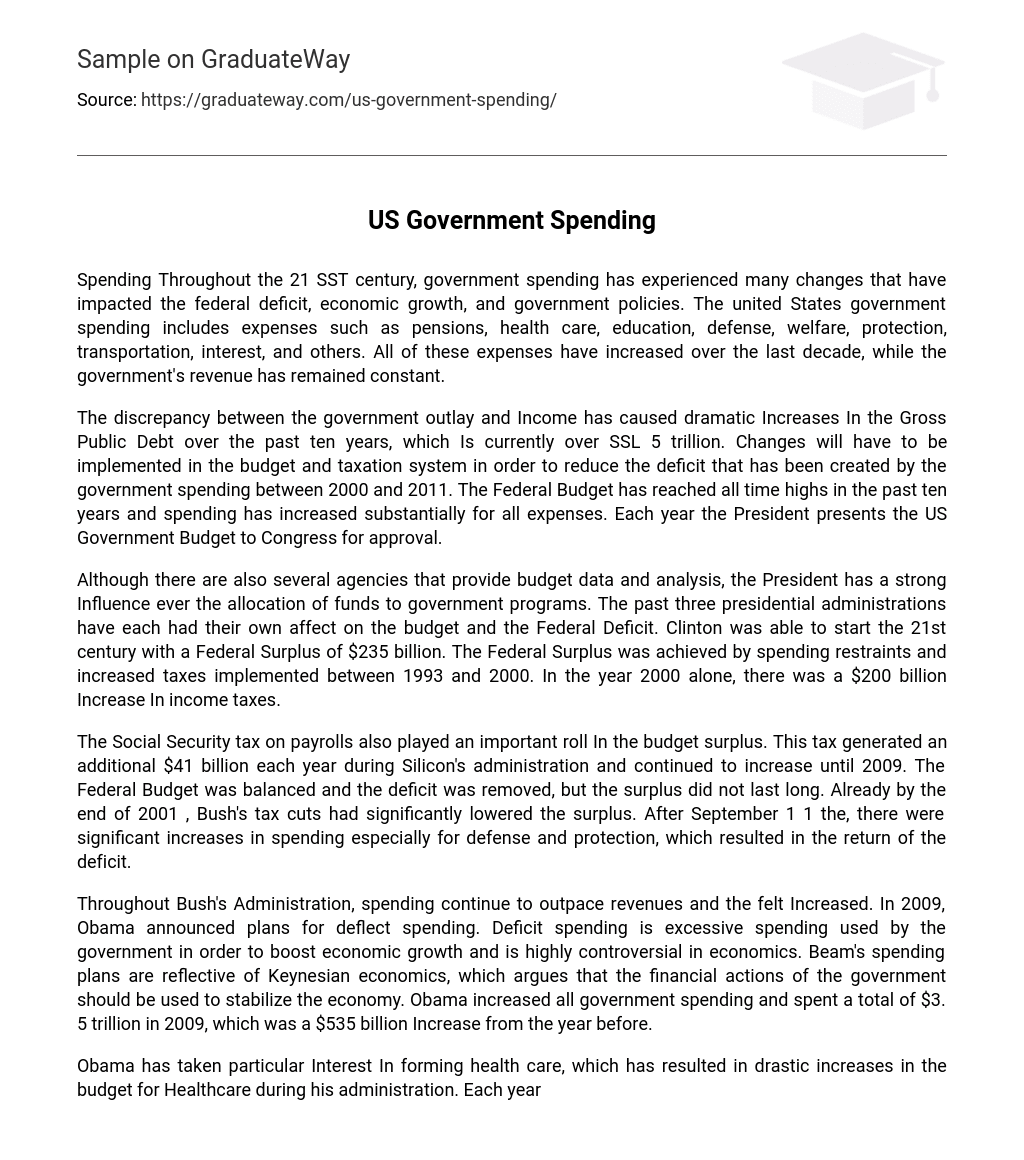Spending Throughout the 21 SST century, government spending has experienced many changes that have impacted the federal deficit, economic growth, and government policies. The united States government spending includes expenses such as pensions, health care, education, defense, welfare, protection, transportation, interest, and others. All of these expenses have increased over the last decade, while the government’s revenue has remained constant.
The discrepancy between the government outlay and Income has caused dramatic Increases In the Gross Public Debt over the past ten years, which Is currently over SSL 5 trillion. Changes will have to be implemented in the budget and taxation system in order to reduce the deficit that has been created by the government spending between 2000 and 2011. The Federal Budget has reached all time highs in the past ten years and spending has increased substantially for all expenses. Each year the President presents the US Government Budget to Congress for approval.
Although there are also several agencies that provide budget data and analysis, the President has a strong Influence ever the allocation of funds to government programs. The past three presidential administrations have each had their own affect on the budget and the Federal Deficit. Clinton was able to start the 21st century with a Federal Surplus of $235 billion. The Federal Surplus was achieved by spending restraints and increased taxes implemented between 1993 and 2000. In the year 2000 alone, there was a $200 billion Increase In income taxes.
The Social Security tax on payrolls also played an important roll In the budget surplus. This tax generated an additional $41 billion each year during Silicon’s administration and continued to increase until 2009. The Federal Budget was balanced and the deficit was removed, but the surplus did not last long. Already by the end of 2001 , Bush’s tax cuts had significantly lowered the surplus. After September 1 1 the, there were significant increases in spending especially for defense and protection, which resulted in the return of the deficit.
Throughout Bush’s Administration, spending continue to outpace revenues and the felt Increased. In 2009, Obama announced plans for deflect spending. Deficit spending is excessive spending used by the government in order to boost economic growth and is highly controversial in economics. Beam’s spending plans are reflective of Keynesian economics, which argues that the financial actions of the government should be used to stabilize the economy. Obama increased all government spending and spent a total of $3. 5 trillion in 2009, which was a $535 billion Increase from the year before.
Obama has taken particular Interest In forming health care, which has resulted in drastic increases in the budget for Healthcare during his administration. Each year the budget undergoes many revisions based on presidential actions, the country’s needs, and economic status, which ultimately affects the Federal Deficit when spending and revenue are compared. The Increases and decreases In taxes have played a large role In the changes In progressive meaning that a higher tax rate is applied to higher ranges of income.
The top marginal tax rate has declined considerably in recent years. The most recent hanged were the Bush tax cuts in 2001 and 2003, which lowered the top marginal rate from 39. 6% to 35%. Obama extended these tax cuts in 2010. The US national debt has grown significantly since 2001, because of the discrepancy between the government’s revenue and spending. Despite the increasing Federal Deficit, the tax revenue has remained around the historical average at 18% of the GAP. The government has the power to tax and therefore has control over their income.
The Clinton years showed how much higher taxes could positively affect the Federal Deficit. Taxes will have to play a role in the debt reduction. Although Silicon’s tax increase fell mainly on the upper-income taxpayers, other tax reforms such as eliminating tax breaks would prove beneficial in raising revenues and reducing the deficit. In order to regulate the Federal budget, many policies are implemented affecting the government’s spending and revenue. The Bush Administration is associated with several well-known economic policies, which greatly affected the deficit.
Bush’s presidency included a combination of tax cuts and expenses from two wars. The increase in spending caused by the wars and the decrease in revenue caused by the tax cuts resulted in a large increase in the Federal Deficit. 2008 ended with a $9 trillion deficit due to the $1 trillion expense for the war and the reduction of taxes by 4%. Obama has continued the tax cuts and deficit spending. In 2009, Obama proposed a $787 billion stimulus bill, which greatly increased spending while also Implementing tax cuts. The bill was passed in order to help the current economic recession.





